
When it comes to moisture damage and fungi growth, mold and mildew are often mentioned together. Both of them thrive in warm, damp environments and can cause serious problems for your home and health. However, mold and mildew are not the same thing. Understanding the difference between the two is key to effective prevention, treatment, and long-term maintenance.
What is Mold?
Mold is a type of fungus that grows in multicellular filaments called hyphae. These hyphae produce spores that spread through the air. When these spores land on damp spots indoors, they can grow. Mold often appears as fuzzy or slimy patches and can be black, green, red, or even blue. It also tends to penetrate deeper into surfaces, making it harder to remove completely
Common Types of Mold Found in Homes
Cladosporium — This mold is often green, brown, or black and grows on various surfaces, including wallpaper, carpet, and wood. It’s one of the most common indoor and outdoor molds.
Sachybotrys (Black Mold) — This dangerous mold is often found in areas with water damage and can cause flu-like symptoms, headaches, and respiratory problems.
Aspergillus — This mold can be green, yellow, brown, or black and is often found in areas with dust or debris. It’s a common allergenic mold.
Penicillium — This blue or green mold can spread quickly across surfaces, especially in damp areas like bathrooms and kitchens.
Alternaria — This mold is often dark brown or black with a velvety texture. It’s an allergenic mold that can cause respiratory problems.
Chaetomium — This mold thrives in areas with water damage, like leaky roofs or basements. It usually has a musty odor.
Common Places Where Mold Grows
Mold thrives in moist, damp, and poorly ventilated areas, such as attics, basements, and bathrooms. It can also be found in walls, ceilings, and insulation, around leaky pipes or windows, and in HVAC systems.
Health Risks of Mold Exposure
Mold exposure can give people respiratory issues, allergic reactions, and asthma attacks. In rare cases, people can develop neurological effects from toxic molds like black mold.

What Is Mildew?
Mildew is also a fungus, but it tends to be a surface-level problem. It has a powdery or fluffy appearance and is typically white, gray, or yellowish. It is easier to clean than mold and usually doesn’t cause as much damage. Mildew is often considered an early stage of mold growth.
Common Places Mildew Grows
Mildew commonly grows in damp, dark, and poorly ventilated areas where moisture can accumulate. In your bathroom, it can be found on shower curtains, grout, showers, sinks, and toilets. It can also be found in basements, crawl spaces, attics, laundry rooms, around windows and doors, and in underground areas.
Health Risks of Mildew Exposure
Mildew can cause mild respiratory irritation and allergic reactions in sensitive individuals, such as sneezing, a runny nose, itchy eyes, and a skin rash. For those with weakened immune systems, it can increase the risk of lung infections. Long-term exposure can contribute to the development of asthma in susceptible individuals, especially children.
How to Remove Mold and Mildew
Knowing whether you’re dealing with mold or mildew can save you time, money, and even your health.
Mildew can often be managed with DIY solutions and some elbow grease. You can use bleach and vinegar mixed with water, hydrogen peroxide, a baking soda paste, or a mild antibacterial dish detergent. Open windows or fans after cleaning to ensure the area dries completely.
Most mold infestations require professional remediation, especially if the mold is toxic or has spread behind walls or into ventilation systems. But if you determine it is safe for you to remove, make sure you wear gloves, eye protection, and a mask to prevent inhaling mold spores. You can use bleach or vinegar mixed with water, hydrogen peroxide, baking soda, or borax. Like mildew, ensure the area dries completely after cleaning.
To prevent mold and mildew problems, address moisture issues early. Fix leaks, improve ventilation, and use dehumidifiers to reduce potential breeding grounds for mold. You should keep your home’s humidity below 50%.

Mold and Mildew: Unwanted Guests
Mold and mildew may be different, but they both pose a risk to your home and your health. If you notice discoloration or a musty smell in your home, don’t ignore it. Identify what you’re dealing with and either get rid of it yourself or call in a professional. Keeping your home free from mold and mildew protects your home and your family.
